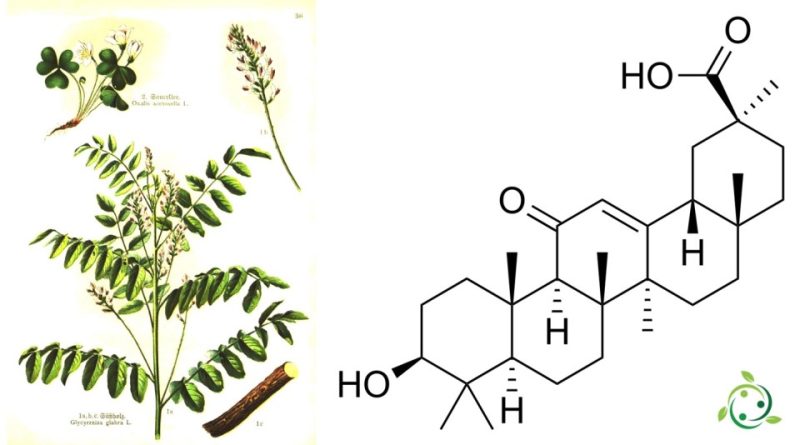Glycyrrhetinic acid
Glycyrrhetinic acid
Glycyrrhetic acid, also known as enoxolone or even 18-β-glycyrrhetinic acid or glycyrrhetinic acid, is a pentacyclic triterpenic organic acid, derived from beta-amyrins, obtained from the hydrolysis of glycyrrhizic acid.
In the official IUPAC nomenclature glycyrrhetic acid takes the term of: acid (2S,4aS,6aS,6bR,8aR,10S,12aS,12bR,14bR)-10-hydroxy-2,4a,6a,6b,9,9, 12a-Heptamethyl-13-oxo-1,2,3,4,4a,5,6,6a,6b,7,8,8a,9,10,11,12,12a,12b,13,14b-icosahydropicene- 2-carboxyl.
Glycyrrhetic acid is a chemical compound derived from licorice root (Glycyrrhiza glabra L., 1758), a perennial plant belonging to the Fabaceae family. It is an active component that gives licorice its characteristic sweet taste. Furthermore, glycyrrhizin (in particular aglycone), from which glycyrrhetic acid is extracted, is also used as a sweetener, being sweeter than sucrose.
From a chemical point of view, glycyrrhetic acid is a pentacyclic triterpenoid, belonging to the class of carboxylic acids. It has a chemical formula of C30H46O4 and a molecular weight of approximately 470.67 grams/mol.
Glycyrrhetinic acid is known for its anti-inflammatory, antioxidant and immunomodulatory properties. It is widely used in the cosmetic and pharmaceutical fields for its multiple applications. It is often employed as a soothing and anti-inflammatory agent in the care of sensitive or irritated skin. Additionally, it has been studied for its potential antiviral, antibacterial, and anticancer properties.
This compound is used in the treatment of peptic ulcer, as an expectorant (antitussive) and healing. It also has other pharmacological properties: antiviral, antifungal, antiprotozoal, antibacterial, eupeptic, emollient, antiphlogistic and cytoprotective. Furthermore, glycyrrhetinic acid, together with glycyrrhizic acid, has a hepatoprotective action, has positive effects on brain damage due to ischemia and appears to have a synergistic effect with anticancer drugs.
However, it is important to note that glycyrrhetic acid can also have some side effects when used in high doses or for extended periods. For example, it can cause fluid retention, increased blood pressure, and electrolyte imbalances. Therefore, it is advisable to use glycyrrhetic acid as directed by your doctor or cosmetic expert and to closely monitor any unwanted reactions.
Warning: The information provided is not medical advice and may not be accurate. The contents are for illustrative purposes only and do not replace medical advice.

